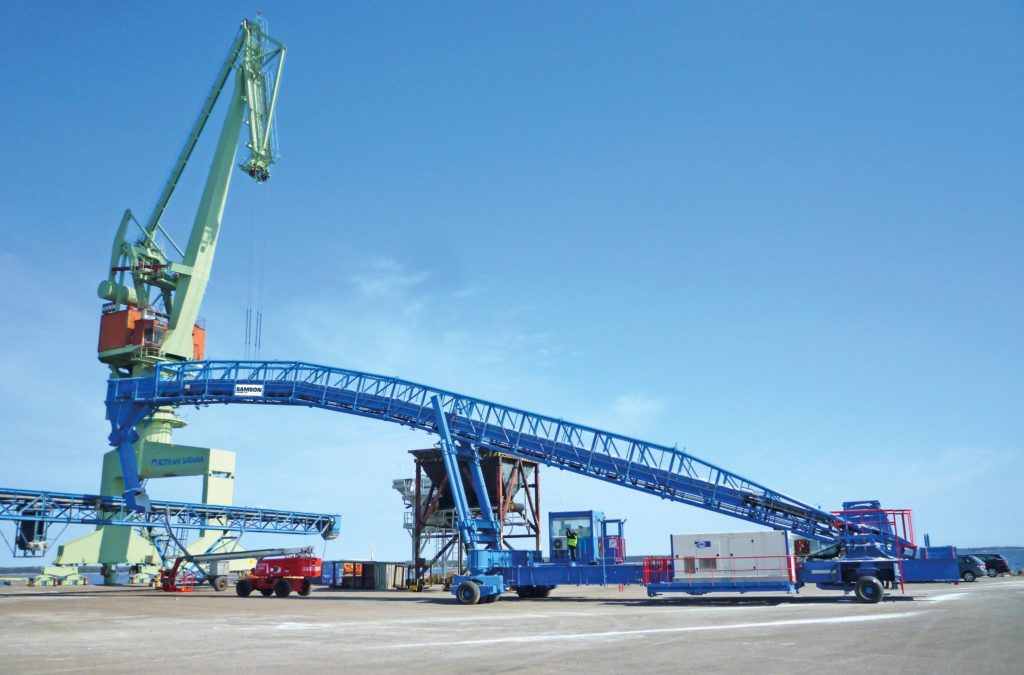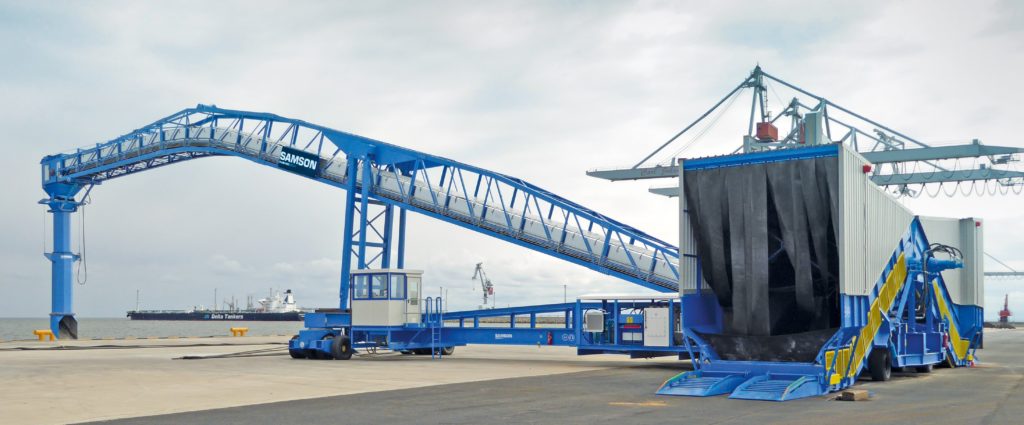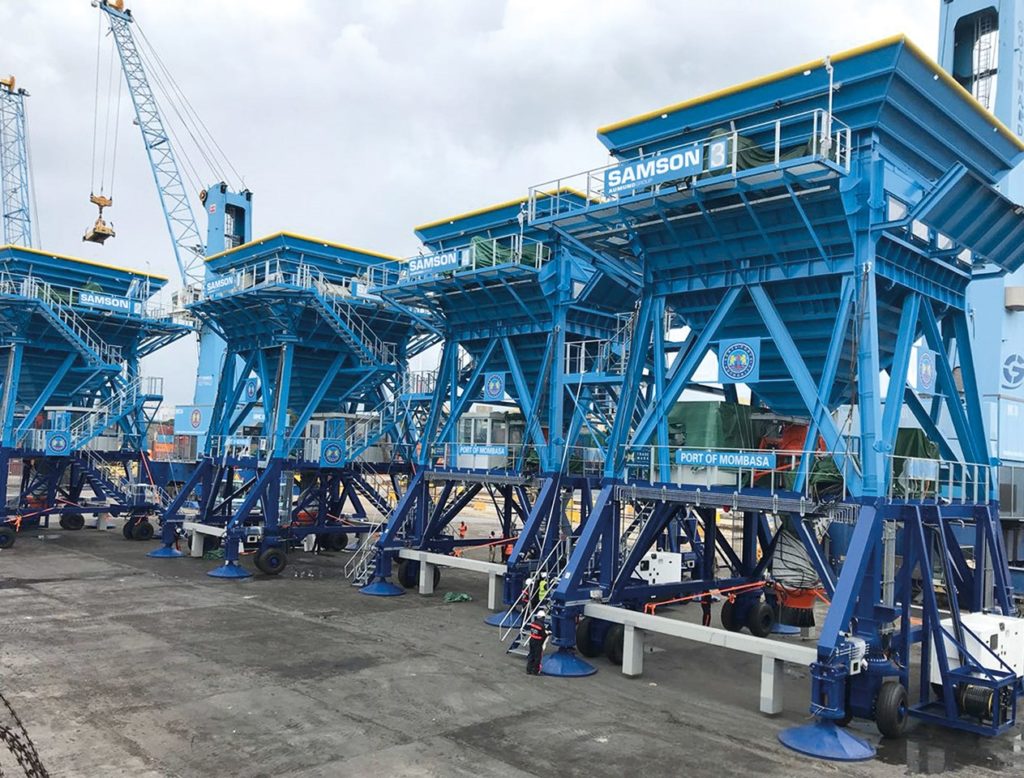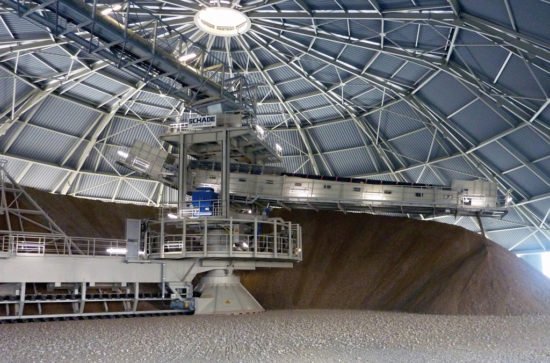SAMSON NEWS 6/2022 – Products. Projects. Progress
SAMSON Materials Handling
The Importance of Flexible Ship Loading and Unloading

The current bulk materials handling landscape continues to place new practical and low environmental impact demands on the cement industry in relation to ship loading and unloading systems. In light of current and future requirements, it is becoming increasingly important for ship loading and unloading solutions to maintain highly adaptable, flexible and eco-friendly operations.
Flexibility, adaptability and eco-friendly solutions in relation to ship loading and unloading systems have received increased attention from researchers, designers and managers based on the fact that infrastructure facilities are required to facilitate various activities. Some undertakings require waterside or landside access, others require extensive berthing, mooring, transhipment or storage facilities, while others entail no facility. Many of the existing industry projects have a design life of several decades that must fulfil current and future demands by providing an increased chance of return on investment (ROI) but also contribute towards sustainability through the efficient use of resources and equipment.
Flexibility and adaptability
In this dynamic and ever-changing industry, equipment plays a fundamental role when flexibility, dependability and environmentally-friendly performance need to be at the core of every product concept: whether for the reception of materials from trucks, rail wagons or ships, or for discharging, for example, onto existing belt conveyors in quarries. The latest trends clearly indicate a shift from the reactive approaches of design to proactive ones that accommodate short and long-term flexibility and adaptability to maximise ROI in the long run.
Most large organisations have overseen that these requirements are provided to each individual customer and their specific demands are met. Since project specifications vary for each client, ship loading and unloading systems need to maintain a highly adaptable and flexible spectrum, including the ability to fully operate on wide and narrow quays or to be stored away when not in use.

Shiploaders
The design of the exemplified SAMSON shiploader includes state-of-the-art mobility options improving the machines manoeuvrability, thus reducing the overall loading time associated with its operation. The benefits gained through this design are reduced imposed loads on the quay surface, whilst maintaining the ability to mount various trimming and dust suppression options to the equipment. It has powered travel that is ideal for narrow quays.
Ecological hoppers
For ship unloading systems, the same two fundamental principles of flexibility/adaptability and low environmental impact apply. New state-of-the-art ecological hoppers, or Eco Hoppers, provide flexible and low environmental impact benefits that can handle virtually any kind of bulk material. These Eco Hoppers can be fixed, rail- or wheel-mounted, ensuring a full range of adaptive mobility options. Two unique added benefits are that they can be used on non-dedicated quays and moved off the area when not in use, as well as their flexible positioning to suit unloading vessels and an ability to work with a wide variety of materials with differing characteristics.
The Eco Hoppers have extensive dust control features (flex flaps, dust seals, dust control filters, air compressor and dust supression systems). They have multiple discharge options: to conveyor, to truck, via telescopic chute, through an ancillary material feeder. The Eco Hoppers also have multiple travel options: rail, static or pneumatic tyre-mounted, or powered and towable travel. Lastly, they have increased safety features (level detectors, strain gauges, structural design to withstand overload to top of skirt). Due to its flexible and eco-friendly design, the throughput of any terminal can be increased by adding one or more hoppers, thus ensuring that onward handling systems can accommodate the increased capacity.

Low environmental impact
Many dry bulk commodities are prone to spillage and can generate dust pollution, posing issues for ports that will become more and more widespread due to ever tightening pollution guidelines, regulations and laws. This is of particular concern for low volume operators who work intermittently or seasonally and will not readily be able to invest in significant infrastructure like those operators and ports that have a constant throughput. Typical bulk cargoes in ports include coal and petcoke, clinker, biomass and mineral ores. Handling these cargoes can generate great quantities of dust. A reduction in the environmental impact when handling these cargoes can be achieved by implementing new and improved dust control filter systems for future machines, or converting existing ones. To extract the maximum use and longevity of current or near future machines, port operators rely heavily on state-of-the-art low environmental impact systems in their infrastructure investments. The ongoing worldwide plans of reducing pollution will see a decrease in flexibility and adaptability of many of the old machines currently used in ports and terminals.
Ports handling dry bulk need to consider the vast differences between handling containers and the issues faced with dry bulk goods. There are six main parameters that influence dust generation when handling bulk materials: falling distance, loading rate, environmental considerations (rain, wind and other conditions), type of transport, material properties (moisture content and particle geometry), loading/unloading technique (equipment used in the process). Flexibility and eco-friendly solutions will see an increase in demand for new infrastructure investments or existing conversion projects.
Predictive Maintenance
In the past decade, manufacturers have also taken the initiative to integrate long-distance maintenance and tracking services for the machines they provide. Because securing high productivity and high machine reliability can be challenging, the AUMUND Group has developed sensor technologies (ie, its PREMAS® 4.0 Predictive Maintenance Solution) which, combined with data collection and analysis, provide online information about the condition of the running machines and also on their environmental impact. Developed for AUMUND and non-AUMUND conveying machines, these solutions help to plan regular maintenance activities, detect machine weaknesses at an early stage and act proactively to ensure operations are not affected.
Conclusion
Future ship loading and unloading systems must offer flexible and environmentally friendly import and export solutions for all bulk materials if they seek to increase the maximum potential ROI and increase the lifespan of equipment. Distinctively-tailored designs to match various types of vessels (eg, from barges to Panamax size) and customer demands will provide an adaptive approach and enhancement in quality of operations in the long run. The examples of equipment provided by SAMSON Materials Handling are equipped with state-of-the-art dust filtration systems which brings the environmental impact close to zero – ranking them among the top current experts in the fields of adaptability and low ecological impact of operations in loading and unloading systems.
Contact
If we can help you with any further information, please use the contact form to get in touch.
You will receive an immediate automated acknowledgement, and we will respond to your enquiry as soon as possible.
Many thanks
AUMUND. SCHADE. SAMSON.






